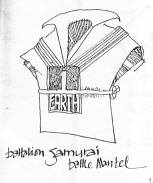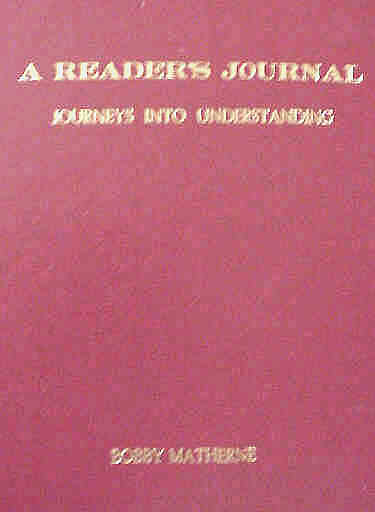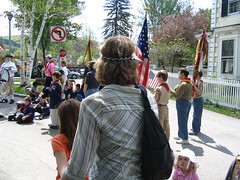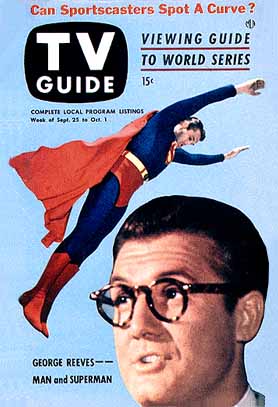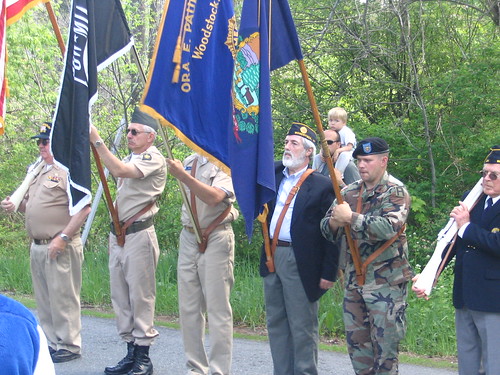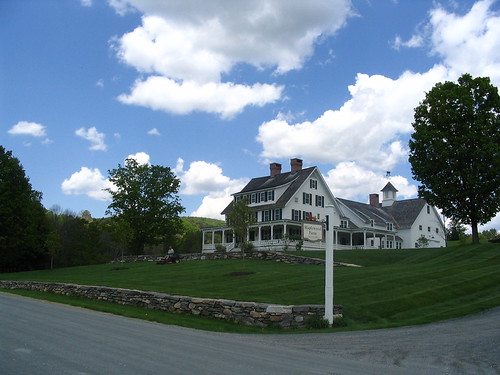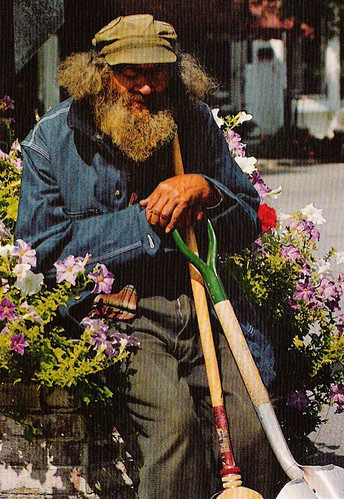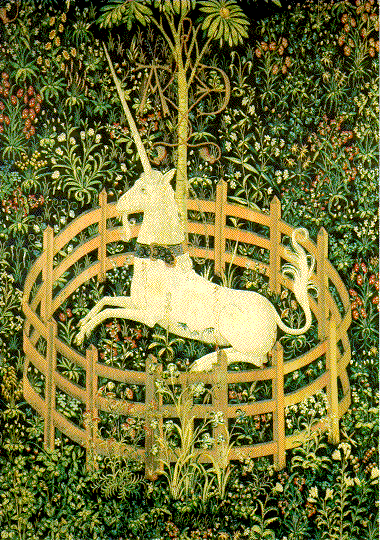About two years ago, I was invited to give a talk at the Anthroposophical Society Green Mountain Branch's annual conference, and I delivered an address that I called "The Vampire & The Unicorn." I must have ad libbed the "Unicorn" half of the talk, for it was missing from this computer file that just showed up. But today, as I begin this blog experiment, I am a lot more concerned about Vampires. Here's what was on my mind around October 2003:
Lately I have felt just like Harry Potter, who, in the most recent book,
Harry Potter and the Order of the Phoenix, crouches in the shrubbery of the Dursley home as he listens through an open window for some foreboding sign to come from the evening news. Living without a television in what
Ladies Home Journal a few years ago christened “the prettiest village in America,” you would think I would be hard-pressed to discover apocalyptic omens in my local environment. In the 1860s, Vermont Senator Jacob Collamer, who lived in a stately brick mansion on Elm Street, a couple of blocks from the heart of the village, called Woodstock a place where the residents have “less incentive than others to yearn for heaven.” The village has been blessed with an extraordinary abundance of peace and prosperity since its founding around the time of the American Revolution, and today tourists flock here from all over America and the world to savor that continuing cornucopia of tranquility, which oozes from every bright white clapboard house, every well-tended garden and window box. If they were looking for an American location to shoot the Privet Lane scenes for the next Potter movie, Woodstock would surely fill the bill. Indeed, back in 1956, Hollywood wanted to film
Peyton Place here, but the good folks of Woodstock sent the producers packing, aghast at what such a marriage of fiction and reality might do to the town’s reputation as a bastion of genteel Yankee propriety.
"When they get near me--I can hear Voldemort murdering my mum."
-- Harry Potter on the Dementors
On the eve of the summer solstice back in June, local kids joined in the nationwide Potter-mania by lining up before midnight at the local bookstore so that they could get their copies of
Harry Potter and the Order of the Phoenix. Three months later, at the fall equinox of 2003, the avalanche of signs has been unmistakable. The war in Iraq, escalating belligerence between Israel and Palestine, and nasty nuclear posturing by North Korea all suggest that the world is on a hairtrigger thanks largely to the imperial actions of the Bush junta. But the flames of war are far from the minds of the leaf-peepers who stream into the village as they tour Vermont to enjoy the flaming maples and golden birches. Hundreds of times each day, visitors will pose in front of the covered bridge, framed by the foliage and a halcyon sky, and give nary a thought to the signs of the week: the latest massive blackout (Italy); the 8.5 earthquake in Siberia; the massive fireballs in India and Australia; the treacherous ‘outing’ of the renegade truth-teller Ambassador Wilson’s wife by Bush’s aides; Arthur C. Clarke declaring that the discovery of vegetation on Mars means sure proof of life on that planet; continued speculation about whether the Dark Star twin of our own sun, or “Planet X” (aka Nibiru) is still due to sideswipe Earth; Arnold Schwarzenegger poised to become governor of California.

We have no public restrooms in the center of Woodstock, so visitors must walk down to the Town Hall, and last week as they entered the building, Arnold would have welcomed them. The movie theater kiosk sported the poster for
Terminator 3: The Rise of the Machines: from out of a fiery apocalyptic background, there marched a horde of monstrous killer robots with glowing red ember eyes. Above them hovered the unmistakable visage of Schwarzenegger the Terminator, the flesh of his stony face peeled away below the cheekbone to reveal synthetic subcutaneous tissue. A smoldering red glow on one of his dark sunglass lenses confirmed his kinship with the menacing machine men.
I had a notion once to manufacture “Leaf-Peepers,” cheap rose-colored glasses that would accentuate the crimsons of the foliage, to sell in all the drugstores and gift shops throughout Vermont. They would sit on the checkout counter right next to the chocolates and postcards, and would rescue visitors from any disappointment that they hadn’t arrived for the much-ballyhooed “peak” foliage moment. Our local drugstore displays no such aids to perception at the checkout counter; instead, you will find little boxes of plastic masks that sport the same expressions as the Terminator and his adversarial horde—the Death Mask, the Darth Vader/Grim Reaper/Evil Alien “look” that seems to have migrated from cartoon robots into our imaginations so deeply that we occasionally see it staring out at us from magazine models.
Or children’s toys. The little masks are the magical “Kanohi” that must be found by the “Toa” heroes to rescue the island of “Mata Nui” from the evil “Rahi” beasts and their demonic leader, “Makuta.” The Lego Company’s ready-made mythology weds Polynesian language and lore to contemporary cyborg fears and fantasy, taking the brightly colored plastic blocks far from the simple construction world Legos once shared with Lincoln Logs and Tinker Toys.
In response to protest from the New Zealand Maori community, who were deeply offended by the appropriation and trivialization of their culture, Lego has changed some of the names of their plastic creations. (For example, the villagers of Mata Nui were originally called “Tohunga,” which is the Maori word for priest; Lego has changed the name to “Matoran”) No such protest has arisen from American parents, who are daily dragged into drugstores and Wal-Marts and K-Marts and Toys R Us by their boys to get the latest
Bionicle action figures, which are promoted by giveaways at McDonald’s, in video games and a soon-to-be-released
movie. The Bionicle Parents Guide reassures parents that the toys reinforce “family values”:
“There is a moderate level of cartoon violence in the built-in storyline. The action is generally stylized, and the biomechanical nature of the toys themselves lend an unreality to the play, which help children separate associations of violence against people when the Toa attack Bohrok, or vice versa. The figures are just humanoid enough for the child to identify with, but not realistic enough that the child will often become frightened for the toy's safety in a comic book or online game.”
Bohrok “swarms” are described in the manufactured mythology as “bug-like multitudes [which] destroy anything in their path.” Photos on the boxes show boys’ hands facing the Bohrok off with the Toa, but just as in the Terminator poster, it is impossible to tell the hero from the villain. Both have the same red-ember eyes, lobster-claw appendages, and Death Mask faces, which bear an uncanny resemblance too to the latest hockey protective masks. It is the visage of the Vampire, the dark, blood-sucking, energy-depleting undead shadow who has haunted the human imagination for millennia.
Despite Woodstock’s perpetually sunny demeanor, the vampire is no stranger here. Chamber of Commerce literature, B&B brochures, and even the occasional local tell of the mysterious Mr. Corwin, exhumed by the town fathers in 1830 from his grave and found to have liquid blood – the tell-tale of the vampire – in his heart. After erecting an iron cauldron on the village green, townspeople are said to have cooked up the vampire’s heart and then buried its ashes along with the pot under a slab of local stone right there on the green. When I moved to Woodstock seven years ago, a backhoe was set up on the green for a week, digging test pits. Though the excavation was part of an archaeological survey mandated by a future road-widening project, everyone in town believed that they were looking for the vampire’s remains.
America need not look underground for vampires, for they have left their crypts and walk in broad daylight among us. Today they do not wear black capes and sport fangs; they have almond-shaped black eyes, pallid skin, and spill out of spacecraft from Orion, Mars, or the Pleiades. And they sit in the governor's chair of our nation's largest state, and in the Oval Office they make their monstrous plans. . .
Now why do my thoughts turn to Vampires today? I have just discovered the "
Rigorous Intuition" blog of Jeff Wells, who deftly dances along the border between the exoteric unfolding of events and their esoteric – he uses the word "occult" – background. I was just about to respond at length to his post from today: "Who shall I say is calling?" when I realized that I had such a different view of who is calling that perhaps it would be better to start a new blogspot.
Jeff takes up the question of San Francisco radiologist
Robert Lull's recent murder, as just one of 44 scientists with expertise in the field of infectious disease who have apparently been murdered since 9/11. He and others have sensed dark conspiratorial forces behind these murders, but I believe that they do not follow the trail far enough. . .
The sense of dread for anyone following these horrible events inevitably combines with an acute sense of excitement that one is playing Sherlock Holmes, looking for clues in the ether, and matching wits with some very sinister adversaries. But all of the Web sleuths with which I am familiar – from Michael Ruppert to Amy Goodman to the Cockburn brothers and Jeff Wells and his fellow bloggers – end up in the position of the detectives from Edgar Allen Poe’s tale, "The Purloined Letter." They enter the room where the thief has concealed the letter, whose appearance he has changed by removing the original black seal and replacing it with a small red seal. The thief hid the letter in plain sight by smudging the paper and placing it in a card rack with other correspondence. The full force of the police department--all of whom have the incorrect search image--makes no progress in finding the letter. After their first failed search, they partition off the room into a grid and search every square systematically, but still it eludes them.
The police know without a doubt that the letter is there, but they can never find it. The small but skilled and incredibly dedicated force of investigative journalists who have attempted to connect the dots of the global web of terror spun since 9/11 similarly know without a doubt that a pack of Vampires has been and continues to be at their dark work, sucking the blood both from very specifically targeted individuals like radiologist Robert Lull, and from humanity’s shrinking reservoir of hope and good will. These invisible foes have been – up until now – as successful as Poe’s thief at hiding in plain sight.
Poe trafficked plenty with Vampires; his poetry and fiction rang hauntingly true because he’d seen them and felt them breathing down his neck. And Poe, like almost all investigative journalists today, was himself a dupe of the Thief, the
Grand Vampire, since Poe – and all of us clever liberals – don’t believe that there are spiritual beings, good and evil, who intervene in human events. Their invisibility guarantees that all the muckraking and connecting of dots will produce no letter; unless today’s trackers of terror acknowledge the spiritual Vampires who inspire and direct these dark events, their earthly representatives will continue their bloodletting.
When I first read about the epidemic of murdered epidemiologists, I thought of a lecture given by Rudolf Steiner on the 6th of November, 1917, entitled "
Behind the Scenes of External Happenings.” Steiner begins by speaking of two political assassinations – the murder of the Empress of Austria in 1898, and of French President Sadi Carnot in 1894 – committed by European anarchists. He links these assassinations to the secret Eastern order whose name became the moniker for all political murder – the Order of the Hashashin (i.e., “Assassins”). Like all of Steiner’s lectures, one must read this lecture at least three times before its full significance becomes apparent. I encourage you to read the lecture in its entirety – you will find it
here on James Stewart's remarkable Rudolf Steiner E-library site – but I will also attempt a summary here.
Working from his clairvoyant spiritual scientific research, Steiner outlines how, in recent times, small groups had discovered how to wield enormous influence over large masses of people. He asserted that in the late 19th century, occult orders had strenuously argued over how this power could be kept from the wrong hands. Along with this knowledge came the ability to understand the workings of disease:
Rudolf Steiner: “Two possibilities exist: information about these things will either be conveyed to men in a form which does harm, or it may be imparted in a way which is for the good of the world. These things are connected with the most intimate depths of certain conditions relating to human propagation, with circumstances connected with illnesses and with the onset of death, and when knowledge concerning them spreads among mankind they give rise to thoughts and impulses of deep import and significance.”
In the spirit of the esoteric truth that all evil is just good “out of its time,” Steiner shows how, by assassinating certain individuals, the occult order was able to gain knowledge of secrets which would have remained concealed until a future time. The particular individuals selected for assassination, as they passed through the Gate of Death, would become privy to knowledge earlier than would be helpful to human progress. The “senselessness” of these late 19th century assassinations made perfect sense to the assassins, who, by targeting these particular individuals, knew full well that they could gain otherwise inaccessible secrets to help them in their quest for power. In order to receive the knowledge which these now dead individuals received once they passed into the spiritual world, the Assassins made use of mediums who, in somnambulic trance, could “catch” the reflection of the premature knowledge.
My hunch is that Carnot and Empress Elisabeth were targeted because they would receive knowledge which the assassins would find useful in their manipulations of the world political order. What illicit knowledge are the Vampires seeking in their murder of these 44 scientists? Rudolf Steiner in 1917 leaves us a remarkable clue. The art of controlling the masses was one aim of this dark order; the other:
"is something that will play an important role in the future: it is a matter of acquiring the secret means whereby factors connected with processes of disease, with the process of propagation, may be given a particular turn."
If you are like me, you will likely immediately interpret this to mean that by acquiring – through occult, i.e., magical, means – expert knowledge of the working of disease, dark occultists acquire “weapons of mass destruction” – biological weapons. But such knowledge – and the actual biological arsenals – is widespread, and one needn’t use magical means to amass either the weapons or the techniques to produce them.
Steiner intuits a much more terrifying end of this activity: in the future, human beings will be given inoculations to prevent them from realizing that they are spiritual beings. Anyone believing in a spiritual world will be labeled insane:
"Attempts will be made to achieve this end by inoculations; just as viruses have been discovered as means of protection against illnesses, so certain inoculations will be used to influence the human body in such a way that it provides no place for the spiritual proclivities of the soul. Human beings will be immunised against any predisposition for spiritual ideas ... such, at least, will be the endeavour. They will try by inoculation to bring it about that even in childhood, human beings lose the urge towards the spiritual life."
This last comment by Steiner invites the interpretation that the process of inoculation has already begun, via the use of mood-altering drugs like Ritalin, Prozac, Zoloft and others. But this apparently is only a beginning.
Without further comment upon this stunning revelation of a future where George Orwell and Aldous Huxley’s dystopian visions merge into something doubly darker than
1984 or
Brave New World, Steiner then turns to the past to explain the cause of all this darkness. He describes the battle that took place in the spiritual world between 1841 (which he calls “The Abyss of
Materialism”) and 1879. During that time, Spirits of Darkness, essentially backward or fallen Angels, attempted to prevent certain spiritual wisdom from reaching humanity. My understanding is that that wisdom eventually DID reach humanity, in the “Anthroposophy” or Spiritual Science, of Rudolf Steiner, who unfolded this wisdom between 1899 and his death in 1925. In 1879, the Spirits of Darkness were vanquished and cast down to Earth – an event that is pictured as the victory of the Archangel Michael, or St. George, over the Dragon. This victory in 1879 meant that humanity itself has become the battlefield where the Dragon – and his minion Vampires – wages war. 
"In 1879, therefore, [the Spirits of Darkness, aka Vampires] were cast out of the spiritual world into the world of men — and here, in this world, they wander among humanity. They are present here, sending their forces into men's thoughts, feelings and impulses of will, egging them on to this undertaking or another. They have not been able to prevent the onset of the age when the spiritual knowledge flows down — their defeat in the battle lies precisely in this — for the spiritual knowledge is here and will unfold increasingly; human beings will be able to acquire the faculty of seeing into the spiritual world.
But having been cast down to the Earth, these Angeloi-Spirits are intent upon doing harm with the down-flowing knowledge; they want to guide it into wrongful channels, to rob it of its power for good and lead it into paths of evil. In short, having been cast down since the year 1879, their aim is to achieve here, with the help of men, what they were unable to achieve with the help of the Spirits in yonder world. Their aim is to bring ruin to that part of the good plan for world-evolution which consists in causing the knowledge of the control of masses, the knowledge concerning birth, illness and death, among other things, to spread among men when the time is ripe. These Spirits of Darkness want to spread such knowledge too soon, by means of the premature spiritual births."
I may be just another one of the sleuths looking in all the wrong places for the purloined letter, but I would like to think that the map of the room that I am given by Steiner’s Spiritual Science actually protects me from the epistemological blindness of Materialism. Not only does Steiner offer a way to actually see the whole room, but he gives us the weapons for doing battle with the Vampires:
"The only way to combat the influence of these Ahrimanic Beings is to realise that against certain aims of
Ahriman nothing avails except to see through him, to know that he is there."
“Ahriman”!!! Now that takes us into an even darker Vampiric cave. If you are still listening, I’ll take it up tomorrow. . .
